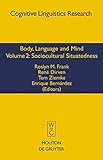Body, Language and Mind. Volume 2, Sociocultural Situatedness / ed. by Roslyn M. Frank, René Dirven, Tom Ziemke, Enrique Bernárdez.
Material type: TextSeries: Cognitive Linguistics Research [CLR] ; 35.2Publisher: Berlin ; Boston : De Gruyter Mouton, [2008]Copyright date: ©2008Description: 1 online resource (436 p.)Content type:
TextSeries: Cognitive Linguistics Research [CLR] ; 35.2Publisher: Berlin ; Boston : De Gruyter Mouton, [2008]Copyright date: ©2008Description: 1 online resource (436 p.)Content type: - 9783110196184
- 9783110199116
- 410
- P107 .B63 2008
- online - DeGruyter
- Issued also in print.
| Item type | Current library | Call number | URL | Status | Notes | Barcode | |
|---|---|---|---|---|---|---|---|
 eBook
eBook
|
Biblioteca "Angelicum" Pont. Univ. S.Tommaso d'Aquino Nuvola online | online - DeGruyter (Browse shelf(Opens below)) | Online access | Not for loan (Accesso limitato) | Accesso per gli utenti autorizzati / Access for authorized users | (dgr)9783110199116 |
Frontmatter -- Table of contents -- Introduction: Sociocultural situatedness -- Section A: The dynamics of cultural -- categorization -- An interview with Mark Johnson and Tim Rohrer: From -- neurons to sociocultural situatedness -- Beyond the body: Towards a full embodied -- semiosis -- Properties of cultural embodiment: Lessons from the -- anthropology of the body -- Distributed, emergent cultural cognition, -- conceptualisation and language -- Collective cognition and individual activity: -- Variation, language and culture -- Section B: The sociocultural situatedness of -- scientific discourse -- Entangled biological, cultural and linguistic -- origins of the war on invasive species -- In search of development -- The language-organism-species analogy: A complex -- adaptive systems approach to shifting perspectives on languageŽ -- Section C: Sociocultural situatedness in lexical -- and usage-based approaches to metaphor -- Toward a socially situated, functionally embodied -- lexical semantics: The case of (all) over -- The embodiment of Europe: How do metaphors -- evolve? -- Sociocultural situatedness of terminology in the -- life sciences: The history of splicing -- Section D: Exploring the sociocultural situatedness -- of language and cognition -- Discourse metaphors -- The relationship between metaphor, body -- andculture -- Idealized cultural models: The group as a variable -- in the development of cognitive schemata -- Backmatter
restricted access online access with authorization star
http://purl.org/coar/access_right/c_16ec
The contributions contained in the second volume of the two-volume set Body, Language and Mind introduce and elaborate upon the concept of sociocultural situatedness, understood broadly as the way in which minds and cognitive processes are shaped, both individually and collectively, by their interaction with socioculturally contextualized structures and practices; and, furthermore, how these structures interact, contextually, with language and can become embodied in it. Drawing on theoretical concepts and analytical tools within the purview of cognitive linguistics and related fields, the volume explores the relationship between body, language and mind, focusing on the complex mutually reinforcing relationships holding between the sociocultural contextualisation of language and, inversely, the linguistic contextualisation of culure. Stated differently, the notion of sociocultural situatedness allows for language to be seen as a cultural activity and at the same time as a subtle mechanism for organizing culture and thought. The volume offers a representative, multi- and interdisciplinary collection of new papers on sociocultural situatedness, bringing together for the first time a wide variety of perspectives and case studies directed explicitly to elucidating the analytical potential of this concept for cognitive linguists and other researchers working in allied fields such as AI, discourse studies and cognitive anthropology. The book brings together several core issues related to the notion of sociocultural situatedness, some of which have been addressed previously, although to a large degree sporadically and from a variety of disciplinary perspectives without fully exploring the possible analytical advantages of this concept as a tool for investigating the role of culturally entrenched schemata in cognition and language. In short, this is the first comprehensive survey of sociocultural situatedness theory.
Issued also in print.
Mode of access: Internet via World Wide Web.
In English.
Description based on online resource; title from PDF title page (publisher's Web site, viewed 28. Feb 2023)


